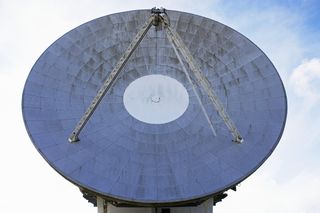New message to aliens will reflect on Earth in danger of climate crisis
A new attempt to reach out to intelligent life in the universe will broadcast information and music about our environment.

A radio signal designed to bring Earth's climate crisis to the attention of alien life will be beamed to the TRAPPIST-1 planetary system in October.
The message has been devised by METI International, a group of scientists, sociologists, historians, anthropologists and artists who have come together with a common belief that humanity would benefit from beaming messages to the stars rather than just waiting to receive a message from aliens. (METI stands for Messaging Extraterrestrial Intelligence, as opposed to SETI, the more passive Search for Extraterrestrial Intelligence.) The Goonhilly Satellite Earth Station in Cornwall, U.K., will broadcast the climate-change message on Oct. 4 to coincide with the beginning of World Space Week, which this year has the theme of "Space and Sustainability."
"Any aliens receiving our message won't be surprised to hear about our climate crisis," Douglas Vakoch, President of METI International, told Space.com. "They've had decades to observe our plight from afar."
Related: What messages have we sent to aliens?
Whether or not aliens already know about us, successfully communicating with them will be difficult. Alien life will not know our languages or understand our culture, and may even interpret the universe around them differently than we do.
"The great challenge of interstellar communication is to establish a common ground for understanding," Vakoch said. To tackle this, the Goonhilly message will begin with the periodic table of elements. Since the chemical elements are universal, any scientifically knowledgeable aliens should recognize the periodic table, METI International argued. That content would create common ground for the message to then describe some of the environmental challenges we are facing here on Earth.
The TRAPPIST-1 system is 39 light-years away, so if anyone there does detect a message, we should not expect a reply for at least 78 years. However, the likelihood is that technologically advanced alien life will be far older than we humans, since the universe is 13.8 billion years old and we're just newcomers on the scene.
Get the Space.com Newsletter
Breaking space news, the latest updates on rocket launches, skywatching events and more!
Related: Climate change: Causes and effects

The message's authors hope that this age gap could offer hope for humans facing the climate crisis. If an alien species has managed to survive perhaps millions or even billions of years, then experts assume that they will have long ago solved any climate issues they may have faced and would now exist in a stable society. Hearing from such aliens might give us confidence that we can solve our own climate problems. Furthermore, Vakoch said he thinks that they may be intrigued to hear from a younger species — us — who are experiencing a stage in their development that the aliens' distant ancestors may also have experienced.
"By giving aliens insight into the mind of a species that is uncertain about its future, but that is still ready to reach out, we may be offering unique insights to a civilization that has long since left behind such instability and uncertainty," Vakoch said. "Our candid self-reflection may just be intriguing enough to prompt a response."
The environmental theme will be portrayed in the message by music as well as scientific information. METI International has teamed up with the Stihia music festival in Uzbekistan, which is a nonprofit project raising awareness of the drying up of the Aral Sea, which local communities rely upon for fishing. The festival's organizers are curating the musical choices in the message, which include tracks such as "Beauty of the Earth" by Soviet electronic music pioneer Eduard Artemyev, "Through the Asteroid Belt" by The Comet is Coming and a selection of tunes from artists performing at the festival, which will be held May 6 through May 8.
Vakoch admitted that the music might be the hardest part of the message for aliens to interpret, as well as being difficult to encode into the message in high-fidelity. Nevertheless, he said he suspects that "the musical selections … are perhaps the parts of the message that are most likely to prompt alien recipients to say, 'tell us more.'"

This year's broadcast will be the second interstellar message that METI International have transmitted; the first was the Sónar Calling message in 2018, sent in conjunction with the Sónar music festival in Barcelona. Other notable interstellar transmissions include Frank Drake's famous Arecibo Message sent in 1974 and four messages beamed into space from the Evpatoria radio telescope in Crimea by the late Russian radio astronomer Alexander Zaitsev.
Some SETI experts condemn actively sending messages to extraterrestrial life. Many researchers consider such communications unauthorized diplomacy that could potentially spell danger for humans because we cannot predict what the consequences of making contact with technological aliens would be for our society.
If one is to send a message, the TRAPPIST-1 system is a good choice, since it is home to seven rocky worlds orbiting a red dwarf star. Several of the system's planets may be habitable, with planet 'e' being the most promising to support life as we know it.
However it's unlikely that METI International will hit pay dirt so soon. "If we get a reply from TRAPPIST-1, we'll know that the universe is chock-full of intelligent life," Vakoch said. "More realistically, we may need to repeat transmissions like the one to TRAPPIST-1 to hundreds, thousands, even millions of stars before we reach one that is inhabited by radio astronomers."
Follow Keith Cooper on Twitter @21stCenturySETI. Follow us on Twitter @Spacedotcom and on Facebook.
Join our Space Forums to keep talking space on the latest missions, night sky and more! And if you have a news tip, correction or comment, let us know at: community@space.com.

Keith Cooper is a freelance science journalist and editor in the United Kingdom, and has a degree in physics and astrophysics from the University of Manchester. He's the author of "The Contact Paradox: Challenging Our Assumptions in the Search for Extraterrestrial Intelligence" (Bloomsbury Sigma, 2020) and has written articles on astronomy, space, physics and astrobiology for a multitude of magazines and websites.
